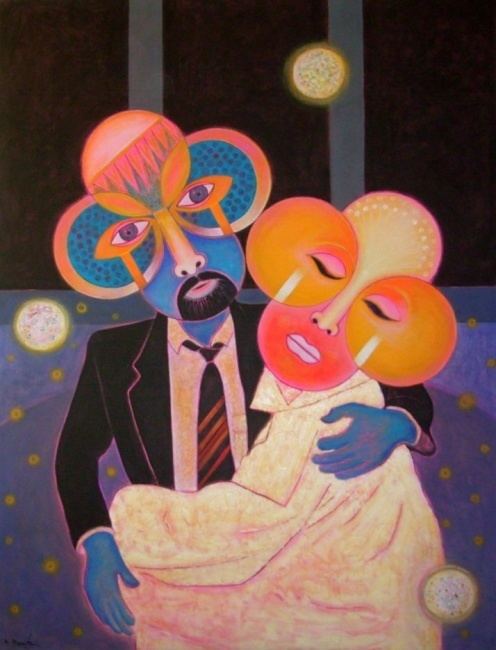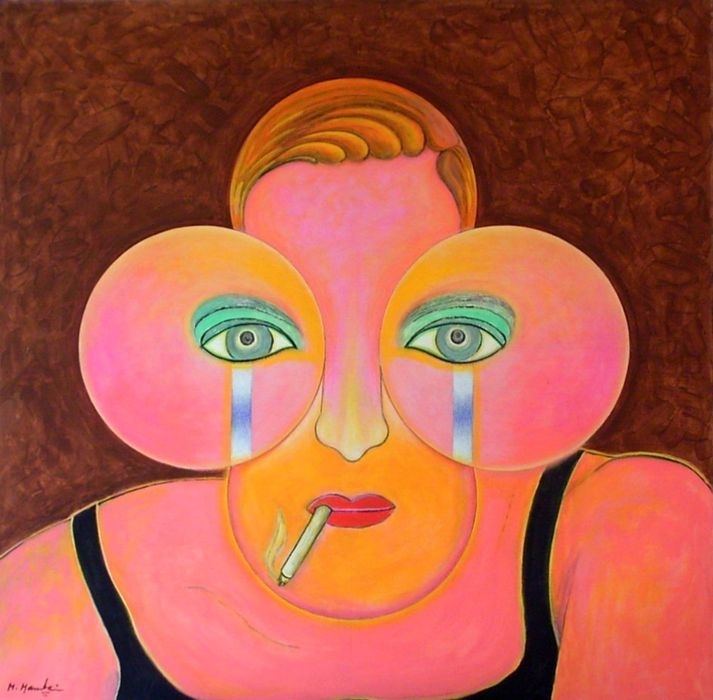Name Mahirwan Mamtani | Role Artist | |
Profiles | ||
Art exhibition mahirwan mamtani at the indian institute of sindhology adipur
Mahirwan Mamtani (born 2 November 1935 in Bhiria (Nawabshah) Sindh, India) is painter, graphic and multimedia artist.
Contents
- Art exhibition mahirwan mamtani at the indian institute of sindhology adipur
- Exhibition mahirwan mamtani at dhoomimal art centre new delhi
- Early years
- Career
- Quote
- Accomplishments
- Graphic editions
- Awards among others
- Literature
- References

Mamtani grew up in India, studied there and moved 1966 to Germany, where he had been awarded a scholarship by DAAD (German Academic Exchange Service) to study painting at the Kunstakademie. Since that time he lives and works in and around Munich.
Exhibition mahirwan mamtani at dhoomimal art centre new delhi
Early years

Already at the age of six in Sindh, Mahirwan Mamtani began to paint, mainly with charcoal and chalks on walls. At the age of 12, due to the partition of India, in 1947 the family moved to Delhi. Because of miserable living conditions as a refugee, lying on sick bed he taught himself without proper schooling. He used to doodle with pencil or pastels on paper. However circumstances forced Mamtani to earn money doing several jobs and his urge to paint was suppressed due to lack of time and money. After some years of such conditions, loneliness and hard work at self-education, Mamtani besides his jobs started studying for Bachelor of Arts and then joined evening classes at the Fine Arts Department of Delhi Polytechnic to study painting. He obtained the National Diploma in 1962. In 1966 he was awarded a scholarship by German Academic Exchange Service (DAAD) to study painting at the Academy of Fine Arts Munich under Prof. Franz Nagel. Since then he is living with his family in and around the Munich and Bavaria area.
Career

Already at the beginning of his studies, Mamtani was aware of Kandinsky, one of the groundbreakers of modernism, who had been searching for spiritual dimensions in art. For Mamtani it can go as far back as William Blake in the 18th century or extend to a German contemporary like Joseph Beuys, who was influenced by the anthroposophic teachings of Rudolf Steiner.
In Munich, in the 1960s, he was influenced by Constructivism, and with his Indian background, by Tantra art. Out of these origins arose his "Centrovision" series, which – already in 1990 – consisted of more than 3000 works.
Quote
The inspiration for Mahirwan Mamtani's conception of "Centrovision" is derived from the manifestation of tantric doctrines. Emanating from the centre toward the outside, his forms are akin to the mandala concept, the visual manifestation of which are based on the axiom of microcosm versus macrocosm. The feeling of procreation is evoked by the rhythmical arrangement of symmetrical, curvilinear organic forms, the roots of which could be traced in the form of the female, the symbol of Shakti, the supreme cosmic energy. Instead of having a flux of light, the paintings are permeated with the whispering tonal values achieved through the integration of colour hues with soft light which becomes the essential ingredient for the modulation of pulsating circular forms.
Some of his earlier multimedia projects were graphic animation films: CENTROVISION (1981) and FACES (1982). Starting in 1990 he built upon an idea from earlier (1985) works, where he had begun to let faces appear in some of his artwork. He performed dances wearing several mandala masks, which he had painted on wood, and recorded these dances in the form of photos and videos with the help of a self-timer. He then painted over the surface of the resulting photo sheets with acrylic colours, creating a series of new mixed-media works of art which he called "Transmuted Fotos". During that time he also experimented with other mixed media.
From the year 2000 onwards, Mamtani created "Mandala Conscious Beings" where he focused on figurative paintings using mandala masks as central elements. This was driven by his urge to deal with human emotions (masks). His remarks were "We all are constantly wearing masks. We are changing the masks, but not removing them."
Around 2003, he also started working on earlier dance videos, recomposing them into new clips (some of them available on YouTube).
Accomplishments
In India Mamtani is counted among the Neo-Tantra artists Biren De, G.R. Santosh, K. C. S. Paniker, Sohan Qadri, Proffula Mohanti, Haridasan, Om Prakash Sharma, P.T. Reddy, Viswanathan. The group exhibited in several museums in Germany, USA and Australia.
In Europe, Mamtani belongs to a group of artists THE SPIRITUAL IN ART – Domenico Caneschi, Italy – Pietro Gentili, Italy – Guy Harloff, France – Joerg Anton Schulthess, Switzerland – Nora Ullmann, Israel. This group was initiated in the 1970s by Dr. Walter Schönenberger, the director of museum in Lugano, who organised several exhibitions in Locarno, Aarau, Milano and Bochum.
